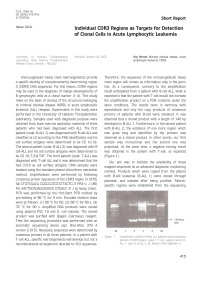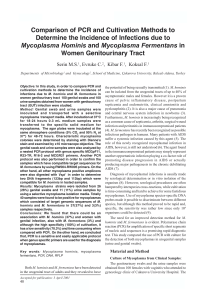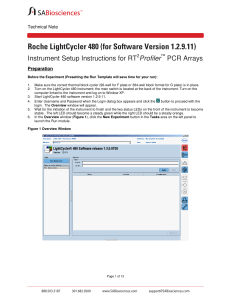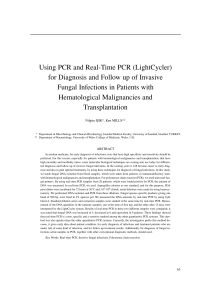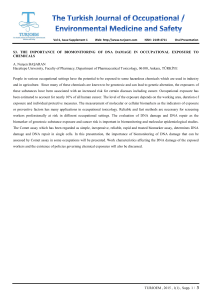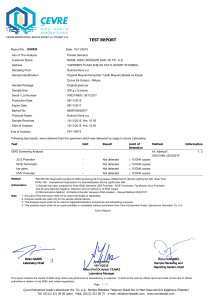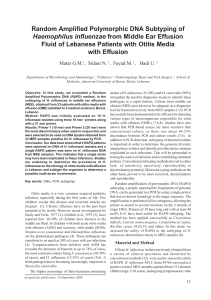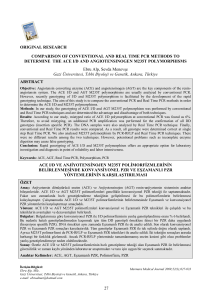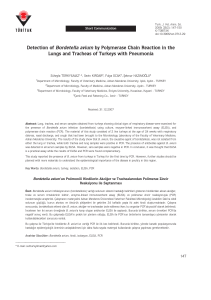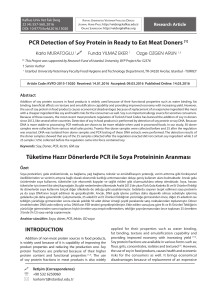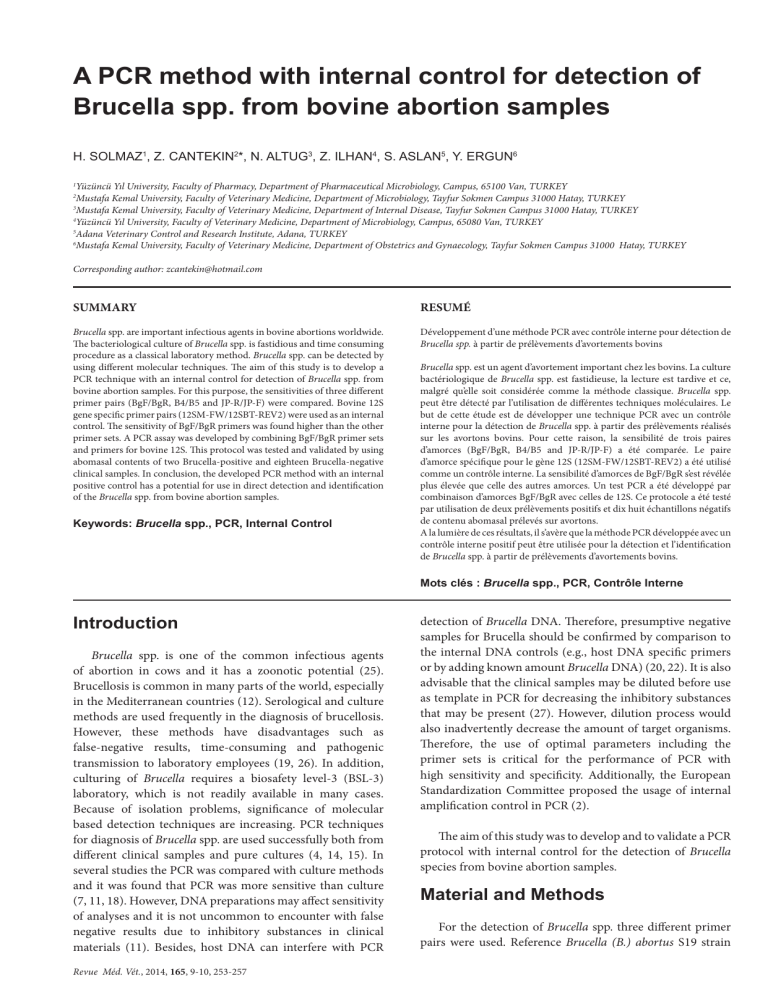
BRUCELLA PCR INTERNAL CONTROL
253
A PCR method with internal control for detection of
Brucella spp. from bovine abortion samples
H. SOLMAZ1, Z. CANTEKIN2*, N. ALTUG3, Z. ILHAN4, S. ASLAN5, Y. ERGUN6
Yüzüncü Yıl University, Faculty of Pharmacy, Department of Pharmaceutical Microbiology, Campus, 65100 Van, TURKEY
Mustafa Kemal University, Faculty of Veterinary Medicine, Department of Microbiology, Tayfur Sokmen Campus 31000 Hatay, TURKEY
3
Mustafa Kemal University, Faculty of Veterinary Medicine, Department of Internal Disease, Tayfur Sokmen Campus 31000 Hatay, TURKEY
4
Yüzüncü Yıl University, Faculty of Veterinary Medicine, Department of Microbiology, Campus, 65080 Van, TURKEY
5
Adana Veterinary Control and Research Institute, Adana, TURKEY
6
Mustafa Kemal University, Faculty of Veterinary Medicine, Department of Obstetrics and Gynaecology, Tayfur Sokmen Campus 31000 Hatay, TURKEY
1
2
Corresponding author: [email protected]
SUMMARY
RESUMÉ
Brucella spp. are important infectious agents in bovine abortions worldwide.
The bacteriological culture of Brucella spp. is fastidious and time consuming
procedure as a classical laboratory method. Brucella spp. can be detected by
using different molecular techniques. The aim of this study is to develop a
PCR technique with an internal control for detection of Brucella spp. from
bovine abortion samples. For this purpose, the sensitivities of three different
primer pairs (BgF/BgR, B4/B5 and JP-R/JP-F) were compared. Bovine 12S
gene specific primer pairs (12SM-FW/12SBT-REV2) were used as an internal
control. The sensitivity of BgF/BgR primers was found higher than the other
primer sets. A PCR assay was developed by combining BgF/BgR primer sets
and primers for bovine 12S. This protocol was tested and validated by using
abomasal contents of two Brucella-positive and eighteen Brucella-negative
clinical samples. In conclusion, the developed PCR method with an internal
positive control has a potential for use in direct detection and identification
of the Brucella spp. from bovine abortion samples.
Développement d’une méthode PCR avec contrôle interne pour détection de
Brucella spp. à partir de prélèvements d’avortements bovins
Keywords: Brucella spp., PCR, Internal Control
Brucella spp. est un agent d’avortement important chez les bovins. La culture
bactériologique de Brucella spp. est fastidieuse, la lecture est tardive et ce,
malgré qu’elle soit considérée comme la méthode classique. Brucella spp.
peut être détecté par l’utilisation de différentes techniques moléculaires. Le
but de cette étude est de développer une technique PCR avec un contrôle
interne pour la détection de Brucella spp. à partir des prélèvements réalisés
sur les avortons bovins. Pour cette raison, la sensibilité de trois paires
d’amorces (BgF/BgR, B4/B5 and JP-R/JP-F) a été comparée. Le paire
d’amorce spécifique pour le gène 12S (12SM-FW/12SBT-REV2) a été utilisé
comme un contrôle interne. La sensibilité d’amorces de BgF/BgR s’est révélée
plus élevée que celle des autres amorces. Un test PCR a été développé par
combinaison d’amorces BgF/BgR avec celles de 12S. Ce protocole a été testé
par utilisation de deux prélèvements positifs et dix huit échantillons négatifs
de contenu abomasal prélevés sur avortons.
A la lumière de ces résultats, il s’avère que la méthode PCR développée avec un
contrôle interne positif peut être utilisée pour la détection et l’identification
de Brucella spp. à partir de prélèvements d’avortements bovins.
Mots clés : Brucella spp., PCR, Contrôle Interne
Introduction
Brucella spp. is one of the common infectious agents
of abortion in cows and it has a zoonotic potential (25).
Brucellosis is common in many parts of the world, especially
in the Mediterranean countries (12). Serological and culture
methods are used frequently in the diagnosis of brucellosis.
However, these methods have disadvantages such as
false-negative results, time-consuming and pathogenic
transmission to laboratory employees (19, 26). In addition,
culturing of Brucella requires a biosafety level-3 (BSL-3)
laboratory, which is not readily available in many cases.
Because of isolation problems, significance of molecular
based detection techniques are increasing. PCR techniques
for diagnosis of Brucella spp. are used successfully both from
different clinical samples and pure cultures (4, 14, 15). In
several studies the PCR was compared with culture methods
and it was found that PCR was more sensitive than culture
(7, 11, 18). However, DNA preparations may affect sensitivity
of analyses and it is not uncommon to encounter with false
negative results due to inhibitory substances in clinical
materials (11). Besides, host DNA can interfere with PCR
Revue Méd. Vét., 2014, 165, 9-10, 253-257
detection of Brucella DNA. Therefore, presumptive negative
samples for Brucella should be confirmed by comparison to
the internal DNA controls (e.g., host DNA specific primers
or by adding known amount Brucella DNA) (20, 22). It is also
advisable that the clinical samples may be diluted before use
as template in PCR for decreasing the inhibitory substances
that may be present (27). However, dilution process would
also inadvertently decrease the amount of target organisms.
Therefore, the use of optimal parameters including the
primer sets is critical for the performance of PCR with
high sensitivity and specificity. Additionally, the European
Standardization Committee proposed the usage of internal
amplification control in PCR (2).
The aim of this study was to develop and to validate a PCR
protocol with internal control for the detection of Brucella
species from bovine abortion samples.
Material and Methods
For the detection of Brucella spp. three different primer
pairs were used. Reference Brucella (B.) abortus S19 strain
254
SOLMAZ (H.) AND COLLABORATORS
was used as positive control. Also, a set of primer pair was
used as internal control to detect bovine 12S gene (Table
I). A total of 20 bovine aborted foetus abomasal contents
were used as clinical samples for validating the developed
technique. These samples were collected from the naturally
infected cases in different farms in Hatay Province, Turkey.
For using as template in the PCR assays, nucleic acids were
isolated one milliliter of from each sample by phenolchloroform extraction method (21).
Bacterial DNA was extracted from control organism
and DNA concentration was measured to 30 ng/µl (Nano
drop Spectrophotometer, ND 1000, USA) to be used as the
template in PCR. Then, 10-fold serial dilutions of stock DNA
solution was prepared and used as template from 3 ng/µl
to 30 f/µl concentrations (21). Sensitivities of primer pairs
for Brucella spp. were compared. Individual PCR assays
with each pair of primer were performed according to the
references as shown in Table I. The most sensitive Brucella
primer pair was then combined with the bovine specific
primer pair for developing the PCR assay with an internal
control for detection of Brucella spp. directly from abomasal
contents of aborted foetus as clinical samples. Extracted DNA
from clinical samples was used to try developed technique.
The multiplex PCR assay was performed according to the
recommendations of Henegariu et al. (10).
The PCR amplification mixture was carried out in a final
volume of 25 µl. The mixture was consisted of 2 µl of extracted
PCR
Set 1
Set 2
Set 3
Internal control
Primer name
DNA template, 1,5 U of Taq DNA polymerase (Vivantis
Technologies), 2,5 µl of 10x PCR buffer (10X ViBuffer A,
without MgCl2 ), 3 mM MgCl2, 200 µM each of dNTPs
(Vivantis Technologies), and 20 pmole of each primer.
After an initial denaturation at 95 oC for 3 min, the PCR
protocol was: 60 s of template denaturation at 94 oC, 60 s of
primer annealing at 54 oC, and 90 s of primer extension at
72 oC (total of 35 cycles), with a final extension at 72 oC for 5
min. The samples were analyzed by electrophoresis in a 1,5%
agarose gel, stained with ethidium bromide (0.5 mg/mL),
and DNA bands were visualized under UV light.
Results
Three Brucella-specific primer sets (BgF/BgR, B4/B5
and JP-R/JP-F) were first evaluated for detection of pure
Brucella genomic DNA in PCR; the highest sensitivity was
achieved with the BgR/BgF primer pair (300 fg was the
lowest concentration of genomic DNA that gave a positive
reaction). It was followed by B4/B5 primer set (detection
limit was 3 pg DNA), and the lowest sensitivity was found
with JP-F/JP-R primers (detection limit, 30 pg DNA). While
BgR/BgF primers (208bp amplification product) and B4/B5
primers (223 bp amplification product) didn’t amplify any
nonspecific products, in PCR with JP-F/JP-R primers (193
bp amplification product) nonspecific amplification products
were seen between 800 and 900 bp. Specific bands for the
primer sets are shown in Fig 1.
Sequences of primers
B4
5’- TGGCTCGGTTGCCAATATCAA- 3’
B5
5’- CGCGCTTGCCTTTCAGGTCTG -3’
JP-R
5’- ACC AGC CAT TGC GGT CGG TA -3’
JP-F
5’- GCG CTC AGG CTG CCG ACG CAA -3’
BgF
5’-CAATCTCGGAACTGGCCATCTCGAACGGTAT-3’
BgR
5’-ATGTTATAGATGAGGTCGTCCGGCTGCTTGG-3’
12SM-FW
5’-CTAGAGGAGCCTGTTCTATAATCGATAA-3’
12SBT-REV2
5’-AAATAGGGTTAGATGCACTGAATCCAT-3’
Length of
amplicon
Reference
223bp
4
193bp
15
208bp
14
346bp
16
Table I: The properties of primer pairs used in this study.
Figure 1: Amplification products of individual PCR assay with primers for Brucella spp. as tested on pure genomic DNA. Lane M:VC 100bp Plus DNA Ladder
(Vivantis Technologies), Lanes 1-6:Products of BgF/BgR primers (208 bp), Lanes 7-12: Products of JP-R/JP-F primers (193 bp), Lines 13-18: Products of B4
/B5 primers (223 bp).
Revue Méd. Vét., 2014, 165, 9-10, 253-257
BRUCELLA PCR INTERNAL CONTROL
In aborted fetal samples, cattle 12S rRNA gene was
detected and cattle specimens were verified by using specific
primers (Fig 2).
255
primers, and they also showed that human genomic DNA
decreased the PCR efficiency in Brucella spp. detection.
Similarly, Mitka et al. (18) and Baddour and Alkhalifa (3)
reported similar result in human blood samples. Also,
Ghodasara et al. (6) indicated that the most sensitive primer
pair was B4/B5 primers in PCR detection of Brucella spp. in
animal clinical samples.
Figure 2: The amplification products of 12SM-FW and 12SBT-REV2
primers specific for Bovine 12S gene. Lane M: VC 100bp Plus DNA
Ladder (Vivantis Technologies).Lane 1: Negative control, Lanes 2-4:
PCR positive abomasal content samples (346 bp).
In the PCR analyses of clinical specimens, two (2) of all
samples (20) were found positive for Brucella with BgR/BgF
primers (208bp amplification product). Also, the developed
PCR assay has been tested on clinical samples that were
known to be positive (n=2) and negative (n=18) fetal bovine
samples for Brucella spp. Specific amplification products for
Brucella spp. (208 bp) and host specific internal control (
346 bp) of developed PCR assay with internal control were
(multiplex PCR) shown in Fig 3.
Discussion
Brucella spp. is one of the most important infectious
abortion agents and causes economic losses in cattle farming.
Due to the disadvantages of culture and serological methods,
use of molecular methods is increasing in practice day by
day. In this study, three different primer pairs were compared
for diagnosis of Brucella spp. The most sensitive pair was
combined with bovine specific primer pair and a PCR assay
was developed for Brucella spp. with internal control. The
developed technique was validated by using positive and
negative clinical samples.
There are different reports about sensitivity of primers for
PCR detection of Brucella spp. Navarro et al. (20), reported
that B4/B5 primers were more sensitive than JP-R/JP-F
Revue Méd. Vét., 2014, 165, 9-10, 253-257
Figure 3: Simplex and multiplex PCR assay amplification product for
Brucella spp.in the positive clinical specimens. Lane M:VC 100bp Plus
DNA Ladder (Firma), Lanes 1-2: Products of simplex PCR for Brucella
spp. with BgF/BgR primers (208 bp), Lanes 3-4: Products of duplex
PCR for Brucella spp. with BgF/BgR primers (208 bp) and for bovine
gene 12SM-FW and 12SBT-REV2 primers (346 bp) .
In this study, BGF/BGR primer pair, reported by Kumar
et al. (14), was found the most sensitive primers for detection
of Brucella species. In a previous report, B4/B5 primer pair
was found more sensitive than JPF/JPR primer pair, similar
to our findings in this study. Moreover, BGF/BGR primer
pair which was found to be the most sensitive primers for
Brucella spp. was combined with the bovine-specific primer
pair 12SM-FW and 12SBT-REV2. This multiples PCR
protocol has been tested with the clinical samples, and the
result were the same as the simplex PCR results.
The use of the internal amplification control is effective for
the detection of the false negative results caused by inhibitors
or mistakes in the various stages of PCR analysis. There are
many strategies for usage of internal control. For this reason,
a bacterial (17) or viral (23) DNA can be added to the mix
which doesn’t exist naturally in specimen, or synthetic DNA
or plasmids (1,8) can be added to the PCR mix. Using host
256
DNA specific primers are also useful for checking the PCR
procedure failures from sampling stage to amplification (9).
Abortions cause significant economic losses in cattle
farming. The economic losses in an abortion case is $700
in USA (24), 480 $ in UK (13) and 538 $ in Turkey (5).
Accurate, reliable and rapid diagnosis of the causative agent
is important for prevention and helps reduce the economic
losses. In this study, Brucella specific primers combined with
bovine DNA specific primers effectively. As conclusion, the
developed PCR method with internal positive control has a
potential use for the detection and identification of Brucella
spp. directly from cattle abortion cases such as aborted
foetuses, milk and vaginal swap samples. For further studies,
applying this method with ruminant gene specific primers
can increase its further use.
References
1. - ABDULMAWJOOD A., ROTH, S. BULTE, M.: Two
methods for construction of internal amplification
controls for the detection of Escherichia coli O157 by
polymerase chain reaction. Mol. Cell.Probes. 2002, 16,
335-339.
2. - ANONYMOUS: Microbiology of food and animal
feeding stuffs. Polymerase chain reaction (PCR) for the
detection of foodborne pathogens. General method and
specific requirements. Draft international standard ISO/
DIS22174. [DIN], Berlin, Germany; 2002.
3. - BADDOUR MM, ALKHALIFA DH.: Evaluation of
3 PCR techniques for detection of Brucella DNA in
peripheral human blood. Can. J. Microbiol, 2008, 54,
352-357.
4. - BAILY G.C., KRAAHN J.B., DRASAR B.S., STOKEER
N.G.: Detection of Brucella melitensis and Brucella
abortus by DNA amplification. Am. J. Trop. Med.
Hyg.,1992, 95, 271-275.
5. - CAN M., F., CEVGER Y., YALÇIN C.: Türkiye’de Brusella
abortus ve Brusella melitensis Enfeksiyonlarından
Kaynaklanan Finansal Kayıplar ve Alternatif Brusella
Kontrol Stratejilerinin Maliyet-Fayda Analizi. Hayvan
Sağliği Ekonomisi ve Isletmeciligi Anabilim Dali,
Doktora Tezi, Ankara,2010.
6. - GHODASARA S., ROY A., RANK D.N., BHANDERI
B. B.: Identification of Brucella spp. from Animals with
Reproductive Disorders by Polymerase Chain Reaction
Assay. Buffalo Bulletin, 2010, 29, 98-108.
7. - GÜLER L., GÜNDÜZ K. OK U.: Comparison of
polymerase chain reaction and bacteriological culture
for the diagnosis of sheep brucellosis using aborted
fetus samples. Vet.Microbiol., 2003, 93, 53-61.
8. - HARTMAN L.J., COYNE S.R., NORWOOD D. A.:
Development of a novel internal positive control for
Taqman based assays. Mol. Cell.Probes.2005, 19, 51–59.
9. - HELPS C., REEVES N., EGAN K.,, HOWARD P.,
HARBOUR D.:Detection of Chlamydophila felis and
Feline Herpes virus by Multiplex Real-Time PCR
SOLMAZ (H.) AND COLLABORATORS
Analysis. J.Clın.Microbiol.,2003, 41, 2734–2736.
10. - HENEGARIU O., N. HEEREMA A., DLOUHY S. R.,
VANCE G. H. VOGT, P. H.: Multiplex PCR-critical
parameters and step-by-step protocol. Biotechniques,
1997, 23, 504–511.
11. - ILHAN Z., AKSAKAL A., EKIN I.H., GÜLHAN T.,
SOLMAZ H. ERDENLIG, S.: Comparison of culture
and PCR for the detection of Brucella melitensis in
blood and lymphoid tissues of serologically positive and
negative slaughtered sheep. Lett.Appl.Microbiol., 2008,
46, 301–306.
12. - JACQUES I., OLIVIER-BERNARDIN V., DUBRAY
G.: Efficacy of ELISA compared to conventional tests
(RBPT and CFT) for the diagnosis of Brucella melitensis
infection in sheep. Vet.Microbiol., 1998, 64, 61–73.
13. - KOSSAIBATI MA, ESSLEMONT RJ.: The cost of
production diseases in dairy herds in England. Vet. J.,
1997, 154.41-51.
14. - KUMAR S., TUTEJA U., SARIKA K., SINGH D.K.,
KUMAR A., KUMAR O.: Rapid multiplex PCR assay
for the simultaneous detection of the Brucella genus,
B. abortus, B. melitensis, and B. suis. J. Microbiol.
Biotechnol., 2011, 21,89–92.
15. - LEAL-KLEVEZAS D.S., MARTİNEZ-VAZQUEZ I.O.,
LOPEZ-MERINO A., MARTİNEZ-SORIANO J.P.:
Single-step PCR for detection of Brucella spp. from blood
and milk of infected animals. J. Clin. Microbiol.,1995, 3,
3087-3090.
16. - LOPEZ-CALLEJA I., ALONSO I.G., FAJARDO V.,
RODRIGUEZ M.A., HERNANDEZ P.E., GARCI T.,
MARTIN R.: PCR detection of cows’ milk in water
buffalo milk and mozzarella cheese. Int. Dairy J., 2005,
15, 1122–1129.
17. - LUND M., MADSEN M.: Strategies for the inclusion
of an internal amplification control in conventional
and real time PCR detection of Campylobacter spp. In
chicken fecal samples. Mol. Cell.Probes., 2006, 20, 92–
99.
18. - MITKA S., ANETAKIS C,. SOULIOU E., DIZA E.,
KANSOUZIDOU A.: Evaluation of different PCR assays
for early detection of acute and relapsing brucellosis in
humans in comparison with conventional methods.
J.Clin.Microbiol., 2007, 45,1211-1218.
19. - MOYER, N.P., EVİNS, G.M., PİGOTT, N.E., HUDSON,
J.D., FARSHY, C.E., FELEY, J.C., HAUSLER, W.J., Jr.:
Comparison of serologic screening tests for brucellosis.
J.Clin.Microbiol., 1987, 25, 1969-1972.
20. - NAVARRO E., ESCRİBANO J., FERNÁNDEZ J.A.,
SOLERA J.: Comparison of three different PCR methods
for detection of Brucella spp. In human blood samples.
FEMS Immunol. Med. Microbiol., 2002, 34, 147–151.
21. - SAMBROOK J., RUSSEL DW.: Molecular Cloning: A
Laboratory Manual, 4htEd. Cold Spring Harbor Press,
New York, 2001.
22. - SCHMİDT BL.: PCR in laboratory diagnosis of human
Borrelia burgdorferi infections. Clin. Microbiol. Rev.,
1997, 10, 185–201.
Revue Méd. Vét., 2014, 165, 9-10, 253-257
BRUCELLA PCR INTERNAL CONTROL
23. - SUO, B., HE, Y., TU, S., SHİ, X.: A Multiplex real-time
polymerase chain reaction for simultaneous detection
of Salmonella spp., Escherichiacoli O157, and Listeria
monocytogenes in meatproducts. FoodbornePathog. Dis.,
2010, 7, 619-628.
24. - THURMOND M.C., PICANSO J.P.: A surveillance
system for bovine abortion. Prev. Vet. Med., 1990, 8, 4153.
25. - WHO. Brucellosis in human and animal. World Health
Organization for Animal Health and FAO. Geneva,
2006.
Revue Méd. Vét., 2014, 165, 9-10, 253-257
257
26. - YOUNG E. J.: Brucellosis, p. 447–451. In D. H. Connor,
F. W. Chandler, H. J. Manz, et al. (ed.), Pathology of
infectious diseases. Appleton & Lange, Stanford, CT,
1997.
27. - ZERVA L., BOURANTAS K., MİTKA S.,
KANSOUZİDOU A., LEGAKİS N.J.: Serum is the
preferred clinical specimen for diagnosis of human
brucellosis by PCR. J. Clin. Microbiol., 2001, 39, 1661–
1664.

